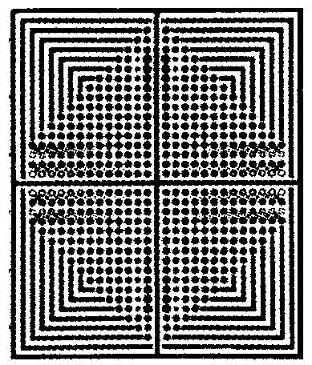Bruner Control Strip for Offset Quality Control Method (II)
Three fine dot micro measurement segments
The fine-mesh micromeasurement section, also called the ultra-micro measurement element, is the core part of Bruner's system (Figure 9-2). The thin network segment is composed of 60 lines/cm isobaric lines, and the total network area is 50%. The fine network segment divides the fine network area into four with equal width and large cross lines. The formation of 1/4 area dot is exactly the same. But in different directions, its main functions are as follows:

(Fig. 9-2 Simplified view of the 50% fine mesh micro measurement)
(1) The outer corner of each 1/4-grid is composed of a 6-line/mm isosceles fold line, which is used as a check for whether there is any sliding deformation or ghosting of the dots during printing. If the four corner lines of the proof are deformed, it indicates that the printed dots have slipped. Lateral sliding, the vertical line becomes thicker, longitudinally sliding, horizontally thicker.
(2) There are 13 outlets in the first row near the reticle, and a row of outlets on the inside is a small black point from large to small, and the next one corresponds to 12 small black dots from large to small. Corresponding to it are 12 hollow white dots from large to small, which are 0.5%, 1%, 2%, 3%, 4%, 5%, 6%, 8%, 10%, 12%, 15 respectively. The % and 20% positivity points correspond to the shade points.
Judging the variation of printing, proofing and printing outlets, 25 times magnifying glass can be used to observe. For example, using PS printing and drying out 10 small black spots, 2% of small outlets are complete. The standard exposure and development of the printing plate should reach the yin and yang points. During the proofing and printing, under the condition of no density meter, the data can be visually enlarged (as shown in Figure 9-3), and the small white hole is observed to have several translucent colors, indicating how much the dots are increased. If the 12 small white holes leave a few translucent, it indicates how much the dots increase. If 12 small white holes are completely stuck, the network will increase by 20%. If 10 small white wells are left dead, 2 small white holes are left, indicating that the outlets are increased by 15%; there are 4 small white holes, indicating that the outlets are increased by 10%. The general proofing specification should retain 4 small white holes.
3 There are 4 50% standard square points in each 1/4 block, which are used to control the depth and depth of layout during printing, proofing and printing. If 50% of the standard squares have large angles, then the dots will increase. If the squares are separated, the dots will shrink.

(Figure 9-3 increase or decrease the visual inspection network)
Yiwu Cnparacord Outdoor & Jewelry Factory , http://www.outdoor-paracord.com